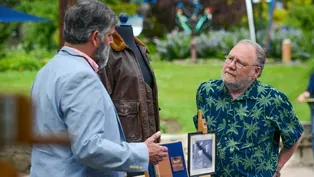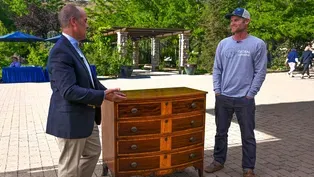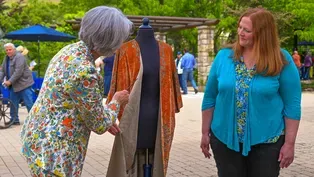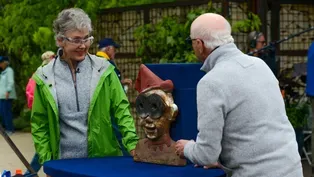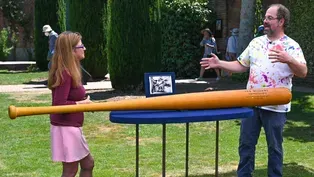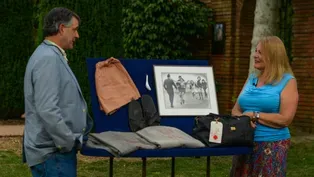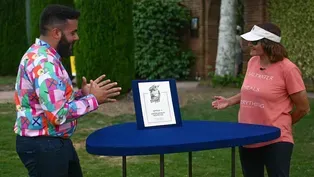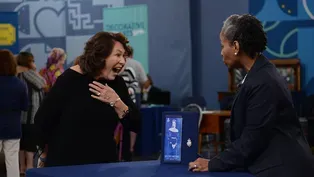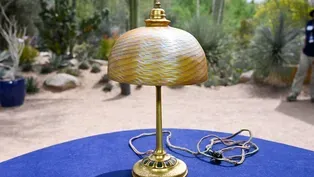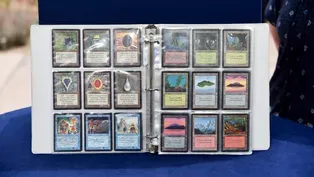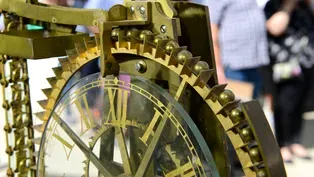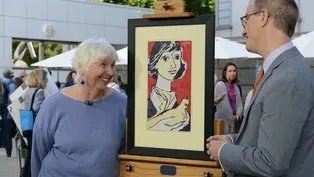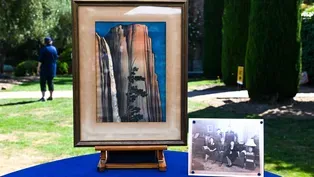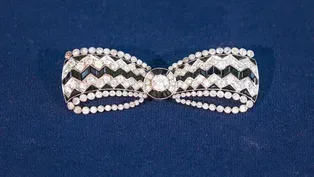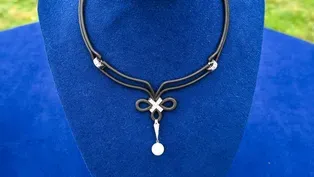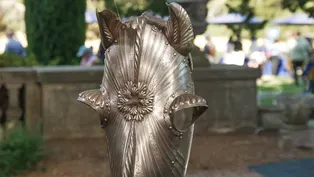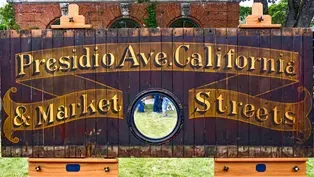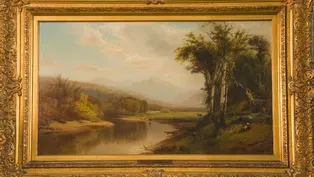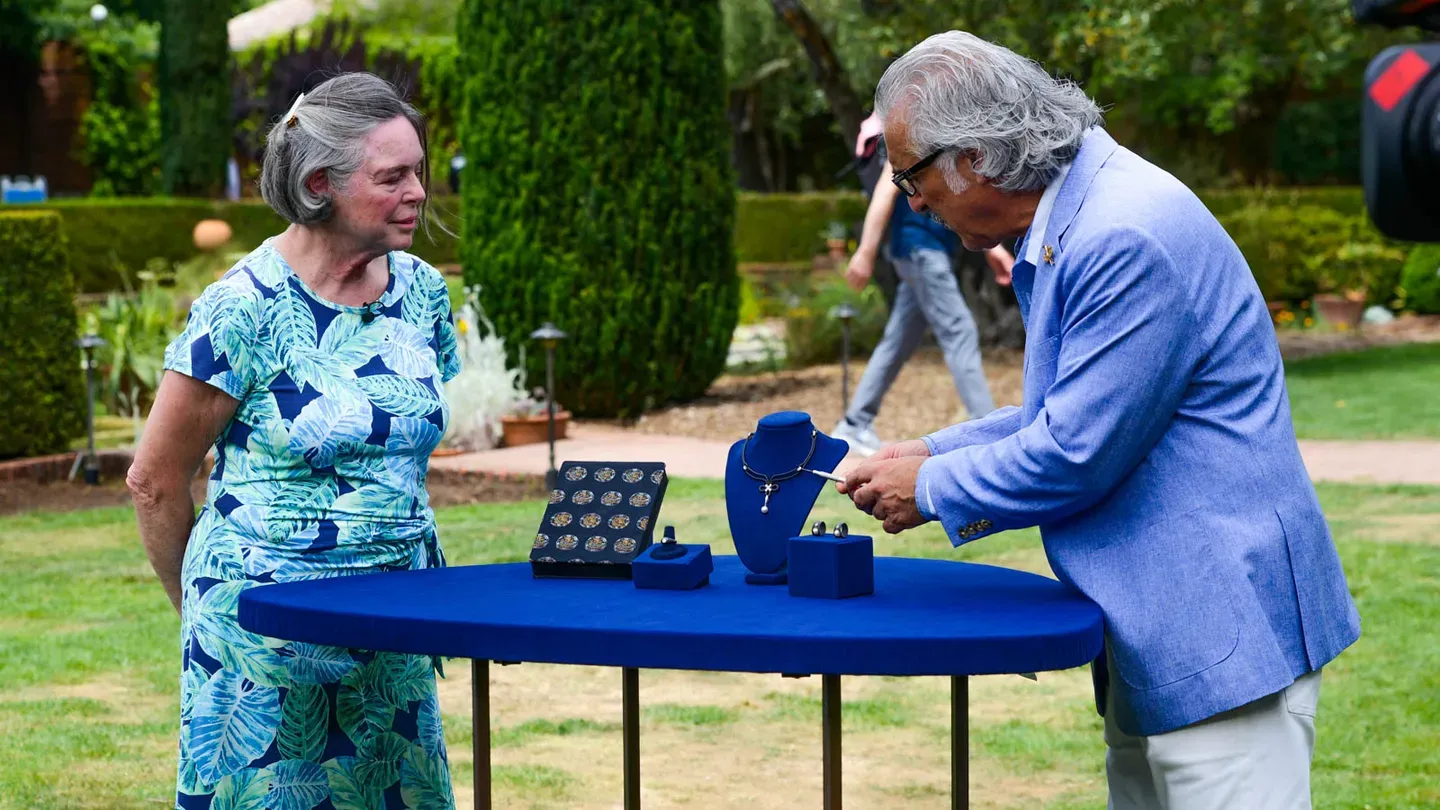

RECUT: Filoli, Part 4
Special | 22m 24sVideo has Closed Captions
Watch wow-worthy Woodside finds in this half-hour RECUT and learn which is up to $44,000!
Watch wow-worthy Woodside finds in this half-hour RECUT, including a Cartier platinum, diamond & onyx brooch, ca. 1925, a beaded West African alligator, ca. 1965, and a G.T. Marsh & Sons jewelry suite, ca. 1940. Guess the top find!
Problems with Closed Captions? Closed Captioning Feedback
Problems with Closed Captions? Closed Captioning Feedback
Funding for ANTIQUES ROADSHOW is provided by Ancestry and American Cruise Lines. Additional funding is provided by public television viewers.

RECUT: Filoli, Part 4
Special | 22m 24sVideo has Closed Captions
Watch wow-worthy Woodside finds in this half-hour RECUT, including a Cartier platinum, diamond & onyx brooch, ca. 1925, a beaded West African alligator, ca. 1965, and a G.T. Marsh & Sons jewelry suite, ca. 1940. Guess the top find!
Problems with Closed Captions? Closed Captioning Feedback
How to Watch Antiques Roadshow
Antiques Roadshow is available to stream on pbs.org and the free PBS App, available on iPhone, Apple TV, Android TV, Android smartphones, Amazon Fire TV, Amazon Fire Tablet, Roku, Samsung Smart TV, and Vizio.
Buy Now

ANTIQUES ROADSHOW 2025 Tour!
Enter now for a chance to win free tickets to ANTIQUES ROADSHOW's 2025 Tour! Plus, see which cities we're headed to!Providing Support for PBS.org
Learn Moreabout PBS online sponsorshipMore from This Collection
RECUT: Idaho Botanical Garden, Part 4
Video has Closed Captions
Wrap up Season 4 of RECUT with a $50,000 appraisal at Idaho Botanical Garden! (22m 31s)
RECUT: Idaho Botanical Garden, Part 3
Video has Closed Captions
Visit the “City of Trees” for unbe-leaf-able Boise treasures in this half-hour RECUT. (22m 31s)
RECUT: Idaho Botanical Garden, Part 2
Video has Closed Captions
In this half-hour RECUT, watch breathtaking Boise appraisals at Idaho Botanical Garden. (22m 31s)
RECUT: Idaho Botanical Garden, Part 1
Video has Closed Captions
Gem State treasures sparkle in this half-hour RECUT at Idaho Botanical Garden! (22m 31s)
Video has Closed Captions
In this half-hour RECUT episode, golden state treasures shine at Filoli. One is $150,000! (22m 23s)
Video has Closed Captions
Watch fascinating Filoli finds in this half-hour RECUT, including one up to $100,000! (22m 36s)
Video has Closed Captions
This season's first half-hour of RECUT wows our guests with a $200,000 to $330,000 find! (22m 30s)
RECUT: American Stories, Part 1
Video has Closed Captions
Learn the stories of objects that represent American traditions and triumphs! (22m 28s)
RECUT: Desert Botanical Garden, Part 2
Video has Closed Captions
Phoenix treasures heat up, like one appraisal up to $35,000, in this half-hour RECUT! (22m 28s)
RECUT: Desert Botanical Garden, Part 1
Video has Closed Captions
Phenomenal Phoenix finds abound in this half-hour RECUT. One is worth up to $100,000! (22m 26s)
RECUT: Crocker Art Museum, Part 2
Video has Closed Captions
See stunning Sacramento finds like one $80,000-$125,000 treasure, in this half-hour RECUT! (22m 28s)
RECUT: Crocker Art Museum, Part 1
Video has Closed Captions
Head to California’s Crocker Art Museum for a bite-sized RECUT! One find is up to $75,000! (22m 27s)
Providing Support for PBS.org
Learn Moreabout PBS online sponsorship♪ ♪ CORAL PEÑA: "Antiques Roadshow Recut" is on the hunt for treasures at Filoli in Woodside, California.
It's a piece of art, so, and, and a iconic piece of San Francisco history.
You're gonna make me cry!
(appraiser chuckles) That's wonderful.
♪ ♪ PEÑA: In this half-hour, "Antiques Roadshow Recut" continues our visit to Filoli in Woodside, California.
The grand former residence is almost 55,000 square feet, with 56 rooms, and originally, had 24 family and staff bedrooms, 15 bathrooms, and 17 fireplaces.
The house alone took three years to complete and cost $425,000.
That's around nine-and-a-half million dollars in 2024.
"Roadshow" saw many impressive items at Filoli.
GUEST: I actually found 'em for 49 cents at a thrift store.
♪ ♪ GUEST: It belonged to my stepmother, who inherited it from her grandmother.
My stepmom was born in 1917, so I think her grandmother probably had her heyday at the end of the 19th century.
Her second husband, I think, gave her this beautiful brooch.
But she had been a single mom and had her own millinery shop in New York.
Wow, wow.
Which at that time was very unusual.
Totally.
I think it's diamonds and onyx.
That's what my, I was always told.
But I don't know exactly the year, or the maker, or anything more.
You're spot-on, it is diamond and onyx.
What I love about it is, these onyx are sort of faceted.
Yes.
So you get that play of the light in the darkness of the stones.
These are old-European-cut diamonds, and all in all, they weigh about five carats.
The piece firmly dates to the Art Deco period.
It's very much in the Deco color palette.
It feels very architectural.
And then, on top of that, what's kind of fun is that it's, it's a ribbon bow, which has been interpreted in jewelry for centuries.
But the best thing about it is that it's signed by the maker Cartier.
Oh, wow!
Do you ever wear this piece?
I never have.
I've always been afraid I'd lose it.
(both laughing) Well, it is a brooch.
Yeah.
Um... And if you turn it over here, you can see that it's marked on the pin stem along the side of the piece.
And then it also has a serial number on the center element.
Cartier was, and continues to be, preeminent jewelry maker to royalty and important socialites, especially at this time.
They were the leaders of this style of jewelry.
Of course, they started as a French firm and expanded into the U.K., and then, ultimately, into New York.
And I feel that this is Cartier New York.
Conservatively, an auction estimate today would be in the neighborhood of $8,000 to $12,000.
Wow, okay!
Yeah.
And I'd expect that it would perform at the high end of that estimate, because it just epitomizes Cartier, 1920s, Art Deco jewelry.
And I chose it 'cause I just thought it was beautiful.
GUEST: Well, we got it from the daughter of our next-door neighbor, who had passed.
And we had helped take care of her while she was elderly, and she told her daughter that she would like us to pick something from the collections that they had in their house.
So my husband went in and picked this, because he liked the lines in it.
He didn't know who it was by?
Well, we suspected, you know, because of the signature, kind of looked like Matisse, and, and the style looked like it.
Yeah.
It is a lithograph by Henri Matisse, dating from the end of his career, in the early 1950s... Wow.
...when his focus became more religious.
He designed for a church in the south of France, in Vence, the Chapel of the Rosary.
It's one of his famous works, with the, the stained-glass windows.
And about the same time, he was making a series of lithographs of the Virgin and Child, which, this is one.
Mm, okay.
So you have the figure... Mm-hmm.
...of the, the mother and child here.
Signed in pencil and numbered, as these were, out of an edition of 100.
He was very scaled down and minimal with his line at this time.
At retail, or replacement, I would put the value of this at $25,000.
Oh!
Tuition!
Cha-ching!
(laughing) One kid!
One kid paid for!
(laughs) No way!
Yeah, it's fantastic, and it's in beautiful shape.
You're... Well, thank you so much-- that's very exciting!
Very good news!
Yeah.
GUEST: I believe this is the front panel of a cable car from San Francisco.
I acquired it two or three years ago at an auction.
I said, "That's something I have to have."
It's a piece of art, so, and, and a iconic piece of San Francisco history.
Yes.
Possibly.
Possibly.
Yes.
Yes, and what did you pay for it?
Uh, $900.
The Presidio and Ferries Railroad Company started operations in San Francisco in 1880.
They started by doing a very long run from downtown San Francisco out to the Presidio Military Reservation.
Right.
That was their original purpose.
Right, this one from Market Street.
From Market Street, which is downtown.
Right.
They ran a cable car system, and it ran up until 1906, when there was a catastrophic event in San Francisco-- the earthquake.
Right.
Many of the cars were destroyed.
Right.
Parts were salvaged.
They rebuilt, as they did with the city, and they were purchased by the City of San Francisco in 1913.
This front of a cable car is what you're thinking it is.
The design pattern is identical to what I've seen on some of the vintage cars.
When we examine it forensically, you have a, a front that's made of separate individual boards.
It's put together in a tongue- and-groove construction.
Tongue-and-groove construction was very, very popular in the late 19th century.
These two boards-- this one and the one over there with the large hole in it-- they're a different wood.
They were a harder wood because there was a bolt that went through here, and that's what bolted it to the front of the cable car.
Then they were covered with a fascia board.
And we clearly see the oxidation mark.
When we examine the paint, we see beautiful gilt, gold letters.
And this would have been painted on by an employee of the cable car company.
And they were called carriage painters.
They were very, very expert at doing this beautiful gold lettering.
And when we look at the patina on this lettering, we see real age.
This is exactly what you want to see when it comes to gilt lettering.
It's absolutely authentic.
Dates to the late 19th century.
This metal bezel, that held the glass lens.
Behind there, originally, was a fuel light that would shine out and magnify onto the street.
So you have an authentic front of a San Francisco cable car.
All right.
Which is pretty amazing piece of, of history.
Right.
Great, I love it.
Now, I'm going to place a retail value on it today of $5,000 to $7,000.
Okay.
So I think you did very well.
That's great.
Congratulations.
All right.
And it's real.
It's real-- that's what I...
Isn't that exciting?
Well, it is.
I like real, not fake.
(laughs): I, I think... Or copies.
I think we all do.
We were given it by our uncle as a wedding gift.
I think it's...
I'm guessing it's from Africa-- that's about it.
APPRAISER: It's West African.
They make 'em in Nigeria, and they also make 'em in Cameroon.
They've become extremely collectible in the past 15 or 20 years.
(chuckling) If I saw this in the shop, I'd expect it to be $300 or $400.
Okay.
Really cool thing.
Thank you, guys, for coming in.
GUEST: I brought a woodblock print that's been in my family for quite some time.
I know it's by Chiura Obata, but I don't know a ton more about the painting itself, aside from it having been in my family since around 1940 or earlier.
Okay, and then we have a picture that you brought in.
Mm-hmm.
Can you tell me what's going on in the picture?
This is my grandfather.
Mm-hmm.
My great-grandfather, great-grandmother, and my grandfather's siblings.
And this is in San Pedro, California, which is the L.A. area.
And the painting is here in the background.
The exact one that we're looking at right now.
Mm-hmm, the same one.
The artist's life is really fascinating.
Okay.
Um, he was born in 1885, in Japan.
And at an early age, he already was a, a, apprenticing to learn sumi-e painting-- line painting, essentially.
And he emigrated to the United States in 1903.
When in the United States, he became fairly successful fairly quickly, despite a lot of racism and xenophobia.
Mm-hmm.
And there are a lot of stories about him having to run away from ruffians.
And this was a difficult time in, in, in history... Mm-hmm.
...for Japanese, uh, immigrants to America.
Mm-hmm.
His talents really kept him going.
He became a very successful commercial illustrator.
One of the subjects that he did love painting was nature, and he loved going into the Sierra Nevadas, and he loved going into Yosemite.
The title of this is "Evening Glow of Yosemite Waterfall."
This is someone who sought to convey the feelings that we would get from being there.
He wanted to bring into his artistic oeuvre and production some of his Japanese techniques.
And one of the Japanese techniques that he would, of course, bring in would have, would have been woodblock printing.
There was a company that made woodblock prints from these watercolor drawings that he made for the, this exact "World of Art" Yosemite book that basically showcased his love of these California landscapes.
Okay.
This was around 1930.
Now, this piece is from that series.
It's signed and dated, uh, "Chiura Obata, 1930."
But there's another part to the history here.
When World War II happened, we all know that, unfortunately-- and this is an, a very unfortunate part of American history-- that a lot of Japanese Americans were interned.
Just looking at this picture, for example, that you brought, which is of your greater family...
Yes.
...what can you tell us?
They were interned.
Before the internment, my great-grandfather was imprisoned under unfounded suspicion of having dealings with the Japanese military.
When he did get out, he passed away a day later.
And then shortly after that, the rest of the family was interned.
But while they were in internment camp, a good friend and neighbor took care of all their belongings.
So that's how we are fortunate enough to still have this painting.
The artist himself was also interned.
Right.
Even being a professor at U.C.-Berkeley, even owning a shop on Telegraph Avenue.
The shop itself was attacked.
Wow.
And he himself was sent to an internment camp.
Okay.
And the really interesting thing about this is that at the internment camps, he actually started some programs for education and art schools.
Hm, interesting.
Even those these were prints, they were really considered masterworks.
They were printed in very limited editions of only 100.
Oh.
We don't know how many of them exist anymore.
Have you ever thought about value or how much you might value it for?
I have no idea.
If I was going to put an insurance value on this today, because I'm assuming you'd probably want to insure it for the family... Definitely.
...I would easily insure it at $20,000.
Wow.
(laughs) Okay.
(laughing) Wow-- that's amazing.
♪ ♪ APPRAISER: What we have here is a country store advertising cabinet from around 1900.
They were designed to draw people in.
Look at the way the horse looks at you.
Mm-hmm.
And what that is is a chromolithograph.
And then, if you open the back, you can see how they embossed it to make it stand out even more.
Mm.
So when somebody came in looking for a veterinary remedy, hopefully, Dr. Lesure was betting on the fact that this cabinet would attract 'em.
This one is probably gonna go in the $3,000 to $4,000 range.
Okay.
Oh, that's really nice, thanks.
Yeah.
My father was a collector of arms and armor here in the Bay Area.
He acquired the piece somewhere in the mid-'90s from a collection in the East Bay.
All I know about it is that it's a chanfron.
I believe it was European.
So what is a chanfron?
My understanding is that a chanfron is a horse's armor for its head.
But I didn't know if this would've been more of a ceremonial or parade piece, versus something that it would've worn into battle.
Well, it clearly would've been something f, for ceremonial purposes.
And one of the reasons we'd say that is because of the etching.
You have these two panels of these winged harpies, and you've got two naked warriors at the base with their spears and their shields, and you have these fluted panels etched with these sort of bold foliate scrolls.
So you wouldn't have invested money in your horse armor with this type of decoration... Sure.
...to lead it into battle.
In many instances, a knight, by his very definition, was a mounted soldier, and he would go to parades and other functions where he would embellish his armor to show his status and his rank.
This is a Maximilian-style chanfron, uh, which would date to the first quarter of the 16th century.
This would have been the style that was popular in Germany at the time.
Okay.
The trick with most armor of this period is determining whether or not it's correct.
Sure.
And whether or not it's a later reproduction.
Okay.
Many of the reproductions are relatively smaller, and this is obviously a very monumental piece, uh, which would have been the proper size.
So the first clue to us is that, yes, it's the large size of it and the quality of the decoration.
There's even some damage at the base that would indicate age.
But the real test in determining the age of armor is to turn it around.
This would have been forged metal, and as such, it would have been hammered on an anvil.
And the interior surface shows no real evidence of hand-forging.
Sure.
And in general, the thickness of the metal is of a uniform.
So I would say that this is a late-19th-century reproduction.
Okay.
But immensely attractive.
Have you given much thought to value?
I know my father paid a few thousand dollars, probably, for it.
I, I don't have a clue of what the market is like currently on it.
I mean, I could throw a number out there and probably embarrass myself.
(chuckles) So I, I would say maybe $4,000?
Renaissance horse armor to begin with is extraordinarily rare, and particularly decorated examples, but oddly enough, equally as scarce are reproductions.
Okay.
At auction, I would estimate its value probably around $5,000 to $10,000.
Fantastic.
And I think it would actually probably do much better.
Sure.
'Cause it's really, it's a handsome piece.
Fantastic, thank you so much.
If this were not a reproduction, I would estimate its, uh, auction value at around somewhere between $200,000 to $300,000.
Wow.
Better luck next time.
(laughs) GUEST: My father-in-law started collecting Asian art.
And G.T.
Marsh and Sons imported many, many beautiful things.
And we're talking around the '40s and '50s, when he was going to s, G.T.
Marsh.
Well, he struck up a relationship with Mr. Marsh and was invited to their family home in Stinson Beach, and took my husband, Bill, with him to create something lovely for his mother.
As a young man, Marsh was traveling from Australia.
He's 15 and says he wants to stay in Japan for a while.
And he starts to absorb the Japanese aesthetics and design.
Um, something as simple as this box that this piece came in, there's Japanese dragons.
He was one of the first to start exploring with mixed metals.
When he's in the shop here, in San Francisco, they have an Italian jeweler, and I really wouldn't know this, except that one of our colleagues, who's not with us anymore, was, like, the Marsh expert.
Really?!
Yeah, his name was Barry Weber.
All righty.
And, uh, and I miss you, Barry.
He taught me about this jewelry.
He just loved it-- he had a passion for it.
This is oxidized steel on the surface.
How do they oxidize it?
Well, this Italian jeweler was a gunsmith.
He knew about bluing gun barrels.
In this particular case, they perfected a technique where they sandblast the metal.
They use chemicals, they use heat, and they would gently give the metal this nice matte finish.
And then in these connectors, they usually used white gold or platinum.
All right.
I did test these.
Okay.
They're white gold-- they are, in all three pieces, diamonds.
And that is a cultured pearl, which would fit with coming out of Japan, and Mikimoto developing the pearls.
Okay.
Now, you have three things here.
I'll, I'll break it down-- the ring.
The ring has a half-carat old-European-cut diamond in it.
All right.
The beauty of the earrings-- you can tell everybody.
What's so fun about the earrings?
The pearls move back and forth.
As you move your head, the pearls swing back and forth.
And it's a spring action.
And they clamp on so well.
At 65 years, they're as good as they were done yesterday!
And women who, um, don't have pierced ears... (chuckling) Right, right.
...love these earrings.
Right.
And they're not too heavy.
No, not at all!
On the necklace, I have to tell you, it kind of blew me away.
You see big brooches, you see pins.
I have never seen a necklace quite like this from Marsh.
(voice breaking): You're going to make me cry.
(laughing) That's wonderful.
It really is fabulous.
I think very realistically and at auction, as a suite, I think you're looking at $30,000 to $44,000.
(inhales deeply): Wow.
Now, to break it down, it's easy $20,000 to $30,000 just for the necklace.
Wow.
Necklace is beyond fabulous.
I believe the earrings would be $5,000 to $7,000.
I believe the ring would be the same.
You might find a ring, you might find a pair of earrings, but you're going to have a lot of difficulty... Finding that.
Thank you so much, Kevin.
(laughing): You're welcome.
You made my day.
You made mine.
(laughs) GUEST: This is one of the Hudson Valley School paintings that was given to me by my parents, who inherited it from my grandmother and my great-aunt.
And who is the artist?
William Hart.
He is considered one of the Hudson River School artists.
The father of the Hudson River School was Thomas Cole.
William Hart is considered sort of a second-string painter in that group, but certainly very accomplished.
And he exhibited all during his lifetime.
And his paintings are in museums around the country.
He was born in Paisley, Scotland, in 1823.
He immigrated to the U.S. around 1830, and eventually to Albany and Troy, New York, area in 1831.
What we find here is a landscape that is of Keene, New Hampshire.
Mm-hmm.
This was a favorite area of his.
Most of the works we see by him are of cows in landscapes, and the cows are rather large and dominate the composition.
Oh.
Those are his later works, done sort, in the late 1870s to '80s.
He, he died in 1894.
This is really refreshing, because it's an early example.
It was done around 1859 to 1861.
Oh.
You can see it's, it's rather fresh.
He has an interesting approach.
He has figures on the right side, the cows are more minimal in the background.
And then, of course, the beautiful landscape and the more or less luminous sky make it a, a rather creative composition for him.
It's signed in the lower right "W.M.
Hart."
And that's a typical signature for him.
The medium is oil on canvas, and the frame is wonderful.
It's, uh, original frame.
Condition-wise, I think it might need a cleaning.
There is a catalogue raisonné of William Hart's work.
Mm-hmm.
This work is listed there.
It does mention that it went through American art galleries in 1925.
You said you got it from your great...?
My great-aunt.
Your great-aunt.
So would she have been in New York around 1925?
She was visiting her brother, who lived in Connecticut, but was a stockbroker in New York.
So, yes, I'm sure she...
So she has... ...traveled into New York.
Perhaps that's where she acquired it.
Unfortunately, the Hudson River School in general is not as much in vogue today...
Yes.
...as it was, let's say, 20 years ago.
If it were in a gallery, I think it would probably sell in the neighborhood of $15,000.
Oh, my goodness!
(chuckling): That, that surprises me, thank you.
Well, you're welcome.
And for insurance, I would suggest $18,000 for insurance.
(stammers): Thank you very, very much, Debra.
Well, you're welcome.
I truly appreciate.
It gives me pleasure every time I look at it.
Aw, well, that's great.
So I'm very pleased to hear all of this.
Oh, good.
PEÑA: Thanks for watching.
See you next time on "Antiques Roadshow Recut."
Appraisal: 1930 Chiura Obata Evening Glow on Yosemite Falls
Video has Closed Captions
Clip: Special | 4m 23s | Appraisal: 1930 Chiura Obata Evening Glow on Yosemite Falls (4m 23s)
Appraisal: Cartier Platinum, Diamond & Onyx Brooch, ca. 1925
Video has Closed Captions
Clip: Special | 2m 25s | Appraisal: Cartier Platinum, Diamond & Onyx Brooch, ca. 1925 (2m 25s)
Appraisal: G.T. Marsh & Sons Jewelry Suite, ca. 1940
Video has Closed Captions
Clip: Special | 4m 6s | Appraisal: G.T. Marsh & Sons Jewelry Suite, ca. 1940 (4m 6s)
Appraisal: Late 19th C. Reproduction Chanfron
Video has Closed Captions
Clip: Special | 3m 21s | Appraisal: Late 19th C. Reproduction Ceremonial Horse Helmet (3m 21s)
Appraisal: San Francisco Cable Car Front Panel, ca. 1900
Video has Closed Captions
Clip: Special | 3m 15s | Appraisal: San Francisco Cable Car Front Panel, ca. 1900 (3m 15s)
Appraisal: William Hart Landscape Oil, ca. 1860
Video has Closed Captions
Clip: Special | 3m 45s | Appraisal: William Hart Landscape Oil, ca. 1860 (3m 45s)
Providing Support for PBS.org
Learn Moreabout PBS online sponsorshipSupport for PBS provided by:
Funding for ANTIQUES ROADSHOW is provided by Ancestry and American Cruise Lines. Additional funding is provided by public television viewers.


